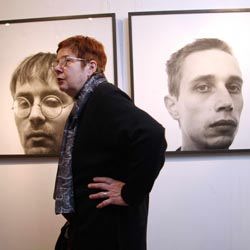Poetic photography
Kyiv hosts an exhibit of the works of Germany’s best photographers
The German school of photography has enjoyed world renown since the 1920s, since the time of legendary art society Bauhaus that united dozens of brilliant photographers. An exhibit of Bauhaus photos was one of the most remarkable events last season in Kyiv. This time the capital city hosts an exhibit of the works of their talented heirs — it was launched under the title “PhotoArt/PhotoKunst” in the SOVIART Gallery on Andriivsky uzviz. The exhibit was organized by the Goethe Institute in Ukraine and the Ukrainian Museum of Visual Arts.
The works of eight artists are on display in SOVIART (that is, if we count the Blume couple as a single artist): Dieter Appelt, Anna and Bernhard Blume, Thomas Florschuetz, Jurgen Klauke, Astrid Klein, Sigmar Polke, Klaus Rinke, and Katharina Sieverding are mainly represented, with the exception of Florshuetz, by black-and-white, bichromatic photos made over a 6-year period, 1969–1993.
It is hard to come up with any formal classification here because deeply original styles have been brought together in the SOVIART hall. A method that is used most frequently is the close-up, but it is applied in diverse ways. Katharina Sieverdieg created series of self-portraits — female faces tinted in various colors, sometimes resembling masks or the run-of-the-mill pop-art production. However, external neutrality contrasts here with powerful inner tension, which bursts out in the composition “Germany Becomes German” (1992), featuring a woman’s face partially covered with a veil and surrounded by circus knives. The title of the photo written above, “Deutschland wird deutscher,” is understood like an alarming warning.
Dieter Appelt works in a different way: his self-portraits resemble sculpture in that they are based on the idea of safely stopped and fixed time, rather than a captured moment. That is why in his works, for example, in “Trace of Time” and “Darkness,” there are stable visual parallels between the human body and the texture of natural materials — wood, soil, and stone. Again, a person is not a part of nature here, but a part of time, which has power both over nature and people. Of all the represented artists, Appelt seems to be most metaphysically-minded, a kind of philosophizing photographer.
Thomas Florshuetz, who came in person and conducted a master class, does not only enlarge faces (in psychological black-and-white portraits of Reiner Schetlinski, Sascha Anderson, Uwe Kolbe, and Stefan Doering), but other parts of the human body as well. Diptychs and triptychs of super-enlarged human fingers or eyes are taken as abstract pictures rather than photos.
Astrid Klein views life in a different way — she reproduces photos taken from the press. “Untitled” (1980) looks like an absolutely self-sufficient graphic opus; we can see only a part of female silhouette from the back; a male hand lies on the woman’s waist as if embracing it, but there is another hand on the sleeve, so upon closer inspection the entire mise en sc ne begins to radiate alarm and danger.
A separate group is formed by the photographers who practice a rather literary approach, constructing stories with certain plots. So “Meeting” (1979) by Jurgen Klauke is a macabre photo story in which each character ridicules the person sitting at the table, depressed, but after the opponent falls down, the scoffer takes his place, with an equally downcast face.
The married couple of Anna and Bernhard Blume portray themselves as the main characters in ironic reflective narrations on the topics that are traditionally considered solely German. For example, respectable burghers find themselves in comic situations after they get lost in the forest while seeking the higher sense (a multi-part photo “Metaphysics is a Business for Men” from the series “In the forest, 1990–1991”).
For Klaus Rinke photography is a part of a much broader activity that includes the creation of large-scale installations and performances carried out by the artist himself. The main subjects of Rinke’s research are water and size of the human body. “Solo for the Superviser of Baths” (1976) documents an event that unites these topics: an artist emerges from a bathing tub, creating a fountain before the astonished audience. And the photo of the Hamburg railway station (1978) features one of Rinke’s installations: eighty 200-liter tubs of water are installed between the rails creating a witty pointer to the city on the water — Venice, where Rinke was going to represent his country on the famous biennale.
Works by Sigmar Polke cannot be interpreted in unambiguously; its external superficial simplicity contains many hidden messages and references to other spheres of art. The series “Mariine” is made of absolutely routine materials: at first we simply see an amateur landscape, a house near a mountain lake, with paints lying nearby; then the painter’s hand appears and starts coloring the barely distinguishable base; finally, a banal picture turns into an absolutely different, original, and talented work. The work unites photography, painting, performance, and collage at the same time; this kind of diversity resembles radical experiments of the 1920s, carried out by the then rebels — dadaists and surrealists.
“Photo Art” is visual proof of what artists may achieve, reaching beyond the boundaries of the narrow genre specialization. Photography executed in this way certainly becomes high art, like painting or poetry, and acquires ambiguity, in the positive sense of the word.






